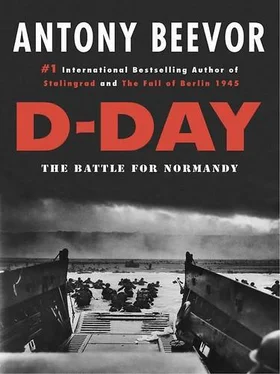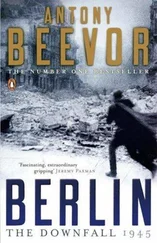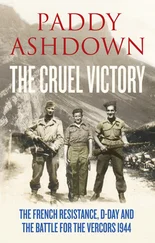He was, of course, referring to the prominent black and white stripes painted round the fuselage and wings of all Allied aircraft to prevent exactly this from happening.
Even after Cherbourg had been captured and made operational, the Americans managed to land much more over the beach than through the port. In the month of August they landed 266,804 tons and 817 vehicles at Cherbourg, 187,973 tons and 3,986 vehicles at Utah and 351,437 tons and 9,155 vehicles at Omaha. The British averaged 9,000 tons a day at Arromanches. They were also able to use small fishing ports which the Germans had not destroyed.
Lord Haw-Haw was the British name for William Joyce, who broadcast from Berlin like ‘Axis Sally’.
The commander of the 4th Armoured Brigade, Brigadier John Currie, was killed that day. He was replaced by Brigadier Michael Carver, aged only twenty-nine.
It is still not clear whether the warning of the attack of II SS Panzer Corps came from the captured plan or from two signals intercepted by Ultra on 29 June, one of which was communicated to the Second Army within four hours. But if the intelligence did come via Ultra, then it is hard to believe that Dempsey had not been told.
One war correspondent on this front, Bob Miller of United Press, wrote, ‘in comparing the average American, British or Canadian soldier with the average German soldier, it is difficult to deny that the German was by far, in most cases, a superior fighting man. He was better trained, better disciplined, and in most cases carried out his assignment with much greater efficiency than we did… The average American fighting in Europe today is discontented, he does not want to be here, he is not a soldier, he is a civilian in uniform.’
According to Bayerlein’s own figures, his panzer regiment had been reduced from 2,200 men and 183 tanks down to just 400 men and sixty-five tanks by the time he reached the American sector in 7 July. The 901st Panzergrenadier-Regiment was reduced from 2,600 men to 600, and the 902nd Panzergrenadier-Regiment from 2,600 to 700.
The Maschinengewehr 42, known as the Spandau in Allied armies, fired 1,200 rounds a minute and was far superior to the British Bren gun or the American Browning Automatic Rifle. Distributed in great numbers within German units, it provided them with a volume of fire which the British and American infantry could never match.
Only 14 per cent of US servicemen sent abroad during the Second World War were infantrymen, yet they suffered more than 70 per cent of the casualties. In Normandy the infantry suffered 85 per cent of the casualties.
Carlo d’Este, however, argues that the British Army seems to have retained an abnormally large force of over 100,000 men for defence of the United Kingdom and other contingencies which could have been used in Normandy.
There are unsubstantiated rumours that Churchill had considered relieving Montgomery just before the capture of Caen, but the shock that this would have caused to British public opinion, as well as abroad, makes this unlikely.
The Centre de Recherche d’Histoire Quantitative at the University of Caen arrived at a total of 1,150 deaths in Caen, 800 in the bombardments of 6-7 June, and 350 during the bombing of 7 July and the shelling and fighting of 8 July. Figures for injured are not available, except that the hospital at the Bon Sauveur cared for 1,734 injured between 6 June and the end of July, of whom 233 died. Lieutenant Colonel Kraminov, a Soviet war correspondent, claimed that more than 22,000 French were killed and buried in the destruction of Caen and that there were no Germans left in the town. This grotesque exaggeration was taken up as anti-British propaganda after the war by the French Communist Party.
One can only wonder with sympathy at the subsequent feelings of the French crews of two squadrons of Halifaxes involved, the 346th Guyenne Squadron and the 347th Tunisie Squadron, after they received messages of thanks and congratulations the next day from Air Marshal Harris, Dempsey and Montgomery.
The 30th Division had suffered over 2,300 casualties since 7 July, 961 in the last two days.
The commanding officer of the 115th Regiment, Colonel Ordway, who had less than an hour and a half’s sleep, returned to his headquarters exhausted. General Gerhardt rang him at 05.30 hours. Ordway was not very tactful. Gerhardt rang back at 6.15 to tell him he was to be relieved. Considering that his first battalion had already started to probe into the outskirts of Saint-Lô, Ordway was angry, as he felt his tactics had achieved success while Gerhardt’s had been disastrous.
The official RAF report later acknowledged the following faults. For the bombing of Area M round Cagny, the early markers overshot. Corrections were made, but smoke and dust soon obscured the target and they failed to destroy a battery of 88 mm guns. In Area I around Troarn on the left, only 18 per cent of the bombs fell within the target area. And for Area P, which covered Hubert-Folie, Soliers and the village of Bourguébus, only 40 per cent of the bombs fell within the target area.
Rommel may well have swung round at the last moment to believe that assassination was the only way. According to General Eberbach, Rommel finally said to him during their meeting on 17 July, just before he was severely injured, ‘The Führer must be killed. There’s nothing else for it, the man really has been the driving force in everything.’
OKH, the Oberkommando des Heeres, was the High Command of the Army, but its real responsibility was the eastern front, while the OKW, the Oberkommando der Wehrmacht, was responsible for the western and all other fronts.
Resistance within the army and plans to remove Hitler began with the Sudeten crisis of 1938. Attempts to kill him also included a failed attempt by a Swiss theology student in 1938 and the Bürgerbräu-Keller explosion of 8 November 1939 by a left-wing Swabian joiner acting alone. Most attempts, however, involved the military resistance. Speidel was part of a plan to seize Hitler at Poltava in February 1943, just after the Stalingrad disaster. Another planned attack failed to take place a month later. Then a bomb was put on Hitler’s Condor aircraft but failed to go off. A third attempt that month, with Gersdorff detonating a suicide bomb, again failed because Hitler changed his programme at the last moment. Another three plans in December 1943 and in the spring of 1944 also came to nothing.
The NKVD directorate under General Sudoplatov planned several attempts to kill Hitler, including one at Vinnitsa in the Ukraine, and another in Germany with an ex-boxer called Igor Miklashevsky and the composer Lev Knipper, the brother of the actress Olga Chekhova. None of these ever came close to being activated.
The two bombs, only one of which Stauffenberg had time to arm, used British fuses. These had been dropped by SOE to a Resistance group in France, and later captured by the Germans. They had then been passed on to the conspirators by a supporter within the Abwehr in September 1943. Stauffenberg had gone with his bomb to Rastenburg twice before, on 6 July and 15 July, but the right opportunity did not arise.
Читать дальше











